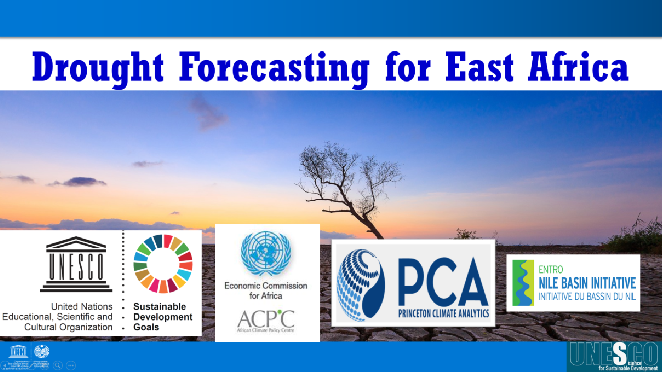Title

Background
Drought is a recurring natural hazard that has large and important impacts on livelihoods, economies and ecosystems across East Africa. Reducing the impacts of droughts requires a range of actions, including the development and use of early warning systems as part of an integrated drought mitigation plan. Early warning systems consist of tools for monitoring and forecasting of evolving drought conditions and their impacts, and the timely provision of this information to government and stakeholders in actionable forms. Early warning should also be accompanied by evaluations of drought risk that includes assessment of vulnerable populations and their coping capacities.

Current capacity for early warning in the region is focused on IGAD and EAC Regional countries, some of the regional institutions like Africa Climate Policy Centre, Regional Centre for Mapping of Resources for Development and IGAD Climate Prediction & Applications Centre (ICPAC) that provides monitoring and forecasting for drought and assessments of drought related impacts (e.g. agricultural production), including contribution to consensus seasonal outlooks as part of the Greater Horn of Africa Climate Outlook Forum (GHACOF). National capability may then combine this with their own analysis to provide more targeted national outlooks and provision of this to stakeholders. There is a need to improve capacity across the region to provide more targeted and sector specific drought information, and in particular to draw from the wealth of information from state-of-the-art data sources, such as satellite remote sensing, models and information systems that provide real-time and forecast information.
Introduction
A workshop is proposed to bring together national representative practitioners from across the region to learn and apply state-of-the-art methods for drought monitoring and forecasting. The training will be focused on using the African Flood and Drought Monitor, which is an online tool that brings together ground observations, hydrological and climate modelling and remote sensing to provide integrated drought monitoring and forecasting in support of risk analysis and early warning. The workshop will also serve to promote broader learning on drought risk management, and development of knowledge sharing networks.
Documents
Presentations
The role of climate information and services in DRR - Frank Rutabingwa
Drought Forecasting for East Africa
The impact of 2011 drought in East Africa (border area between Kenya, Somalia, and Ethiopia)
High Resolution Flood and Drought Monitor (FDM) - Justin Sheffield
The 1984 East African Drought The Risk, Impacts, and Opportunities
Drought occurrence Assessment Using AFDM online tool - A case of Ethiopia
Mapping Water Balance around Lake Turkana
Impact assessment of droughts to livelihoods in Rib catchment (upper Blue Nile), Ethiopia
Training
Seasonal Hydrological Forecasting for Drought Early Warning and forecasting on other time scales
Drought Research at Princeton University and University of Southampton